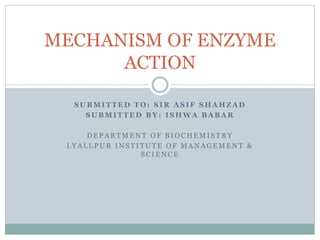Mechanism of Enzyme Action..
•Als PPTX, PDF herunterladen•
0 gefällt mir•49 views
An enzyme attracts substrates to its active site, catalyzes the chemical reaction by which products are formed, and then allows the products to dissociate (separate from the enzyme surface). The combination formed by an enzyme and its substrates is called the enzyme–substrate complex.
Melden
Teilen
Melden
Teilen

Empfohlen
Empfohlen
Weitere ähnliche Inhalte
Ähnlich wie Mechanism of Enzyme Action..
Ähnlich wie Mechanism of Enzyme Action.. (20)
Co-Enzyme and their Role in Regulation in Metabolic Process Presented By Waqa...

Co-Enzyme and their Role in Regulation in Metabolic Process Presented By Waqa...
2024_Chapter_4_Edited_Cellular_Metabolism_and_Metabolic_Disorders (4).pptx

2024_Chapter_4_Edited_Cellular_Metabolism_and_Metabolic_Disorders (4).pptx
Mehr von biocatalysis and Bioremediation lab/GCUF
Mehr von biocatalysis and Bioremediation lab/GCUF (7)
Kürzlich hochgeladen
Kürzlich hochgeladen (20)
Kanchipuram Escorts 🥰 8617370543 Call Girls Offer VIP Hot Girls

Kanchipuram Escorts 🥰 8617370543 Call Girls Offer VIP Hot Girls
FAIRSpectra - Enabling the FAIRification of Analytical Science

FAIRSpectra - Enabling the FAIRification of Analytical Science
The Mariana Trench remarkable geological features on Earth.pptx

The Mariana Trench remarkable geological features on Earth.pptx
Asymmetry in the atmosphere of the ultra-hot Jupiter WASP-76 b

Asymmetry in the atmosphere of the ultra-hot Jupiter WASP-76 b
Thyroid Physiology_Dr.E. Muralinath_ Associate Professor

Thyroid Physiology_Dr.E. Muralinath_ Associate Professor
Bhiwandi Bhiwandi ❤CALL GIRL 7870993772 ❤CALL GIRLS ESCORT SERVICE In Bhiwan...

Bhiwandi Bhiwandi ❤CALL GIRL 7870993772 ❤CALL GIRLS ESCORT SERVICE In Bhiwan...
POGONATUM : morphology, anatomy, reproduction etc.

POGONATUM : morphology, anatomy, reproduction etc.
Role of AI in seed science Predictive modelling and Beyond.pptx

Role of AI in seed science Predictive modelling and Beyond.pptx
Selaginella: features, morphology ,anatomy and reproduction.

Selaginella: features, morphology ,anatomy and reproduction.
development of diagnostic enzyme assay to detect leuser virus

development of diagnostic enzyme assay to detect leuser virus
TransientOffsetin14CAftertheCarringtonEventRecordedbyPolarTreeRings

TransientOffsetin14CAftertheCarringtonEventRecordedbyPolarTreeRings
Module for Grade 9 for Asynchronous/Distance learning

Module for Grade 9 for Asynchronous/Distance learning
Mechanism of Enzyme Action..
- 1. S U B M I T T E D T O : S I R A S I F S H A H Z A D S U B M I T T E D B Y : I S H W A B A B A R D E P A R T M E N T O F B I O C H E M I S T R Y L Y A L L P U R I N S T I T U T E O F M A N A G E M E N T & S C I E N C E MECHANISM OF ENZYME ACTION
- 2. Contents: Introduction to Enzyme Active Site Apoenzyme & Holoenzyme Cofactor & Types Mechanism of Enzyme Action: Lock and Key Model Induced and Fit Model
- 3. Introduction of Enzyme “Enzyme can be defined as are biological catalysts that speed up the rate of the biochemical reactions.” For Example: The enzyme amylase, which is present in saliva, converts starch into sugar, helping to initiate digestion. In medicine, the enzyme thrombin is used to promote wound healing.
- 4. Active Site Enzyme molecules contain a special pocket called the active sites.
- 5. Apoenzyme & Holoenzyme The enzyme without its non protein moiety is termed as apoenzyme and it is inactive. Holoezyme is an active enzyme with its non protein component.
- 6. Important Terms Cofactor: A cofactor is a non protein chemical compound that is bound (either tightly or loosely) to an enzyme and is required for catalysis. Types of Cofactors: Coenymes Prosthetic Groups Coenzyme: The non protein component, loosely bound to apoenzyme by non covalent bond. Example: vitamins or compound derived from vitamins. Prosthetic Group: The non protein component, tightly bound to the apoenzyme by covalent bonds is called a prosthetic group.
- 7. Mechanism of Enzyme Action Formation of enzyme substrate complex by: Lock and Key Model Induced Fit Model Lock and Key Model: Proposed by EMIL FISHER in 1894 Lock and key hypothesis assumes the active site of an enzymes are rigid in its shape. There is no change in the active site before and after a chemical reaction.
- 8. Induced Fit Model More recent studies have revealed that the process is much more likely to involve an induced fit model proposed by DANIYSL KOSH LAND in 1958 According to this exposure of an enzyme to substrate cause a change in enzyme, which cause the active site to change its shape to allow enzyme and substrate to bind.
